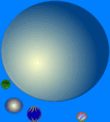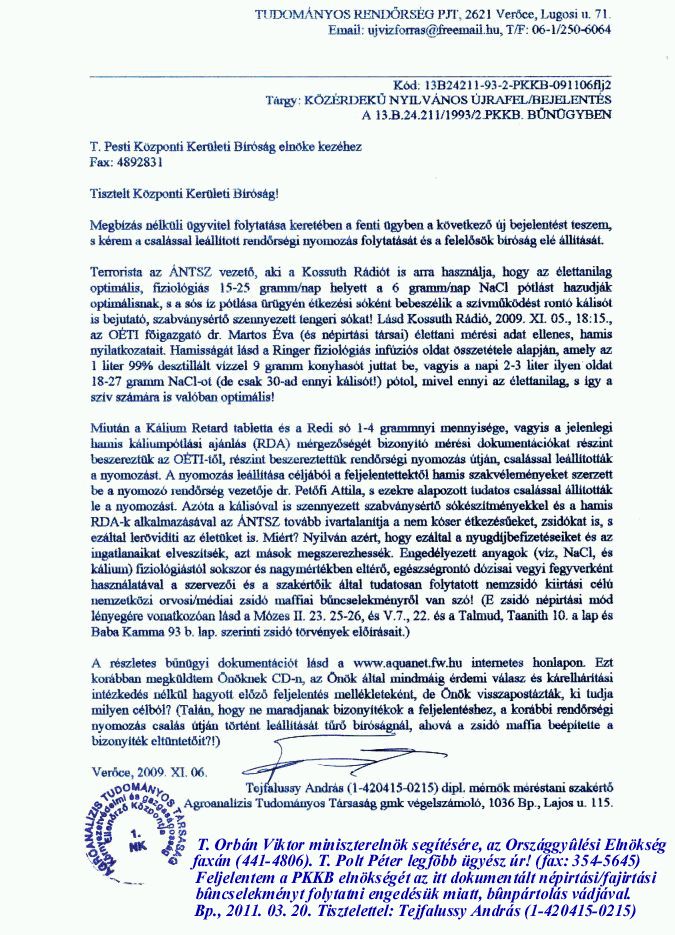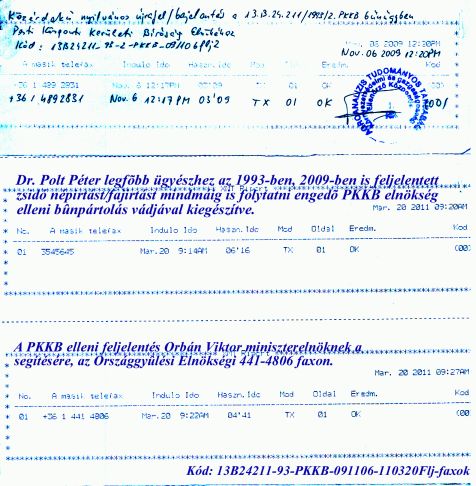 MEZÕGAZDASÁGI KÖRNYZETKÁROSITÁS-ELHÁRITÁSOK
MEZÕGAZDASÁGI KÖRNYZETKÁROSITÁS-ELHÁRITÁSOKAGROANALYSIS SCIENTIFIC SOCIETY (pjt)
Budapest, Lajos u. 115. Hungary 1036 Telefon/fax: 36-1/250-6064, 36-27-380-665
 MEZÕGAZDASÁGI KÖRNYZETKÁROSITÁS-ELHÁRITÁSOK
MEZÕGAZDASÁGI KÖRNYZETKÁROSITÁS-ELHÁRITÁSOK
2.,/ A KÁLIUM-PROBLÉMA (the potassium-problem)
MINISTRY FOR ENVIRONMENT AND REGIONAL POLICY
NATIONAL AUTHORITY NATURE CONSERVATION
Department for Geology and Landscape Protection
H-1121 Budapest, Költõ
u. 21. Phone: (361)1562-133 Fax: (361) 1757-457 Telex: (61)226-115
FTF-538/91.
OTvH-1030/91.
The Potassium
Problem
(Supervision of expertises and recommendations of
Agroanalysis
Scientific Society)
1.)
The National Authority for Nature Conservation completes
the earlier opinion
of MERP ( i.e. Ministry for Environment
and Regional Policy ) related tu suggestion
for solution
of so-called „Potassium Problem” introduced by Centre
for
Environment Protection and Economic Efficiency of Agroanalysis
Scientific
Society (nungarian abbr.:ATT) and its president,
Mr. András Tejfalussy.
( The earlier opinion of MERP was written
according to the instruction of
Dr. Zoltán Illés, deputy secretary
of state about the study
„Economic Environment Protection
by Mr. A. Tejfalussy ( and ATT ), 27th
Sept. 1990.
The supervisory completion becomes to be necessary considering
the difficulty and increasing importance of the solution of the
potassium
problem.
2.) The plants
have a potassium demand, but it has benefical
effect is if available for the
root system in fixed form and
its neccessary quantity is only solved by the
root excretion.
The potassium - as several other chemicals - is poisonous
in
reactive, easy-available form and quantity in soil. In the course
of
the bioevolution the regulation of the potassium uptake developed
under the
condition of the sparingly available potassium form,
therefore the plant are
perfectly unprotected against the
harmful effects of thet easy-available
potassium forms in
fertilizers.
3.)
In the countries, where the agriculture has no deficit, the
potassium fertilization
is almost absent (e.g. in China, Egyp, etc)
or it is used in the case of the
droppingirrigation - since so
damageous effects as its inhibitory influence
on water, nitrogen
or other nutrient acquisition can be neglected according
to artifical
regulation proved by automatic equipment instead of plant
metabolism. (However it can be occured that the deficit of plant
kultivation
does not mean trouble - as e.g. in Izrael, where the
independent food production
means a strategic question of great
importance.)
4.)
The fact published by the AGROANALYSIS Scientific Society
is also verified
by non-Hungarian press, that the potassium
fertilizers are incorrectly interpreted
by all the text books as
yield increasing nutrient, since just the potassium
fertilizers
can be very damageous and harmful for both the food crops and
the animals or the men consumed the food crops in question.
5.)
It is really necessary to draw the attention of all the responsible
organizations
and authorities to that the potassium has not produced
only the plant cultivation
of deficit, but it is dangerous, noxious to thet
human health!
Everybody
has to know the following informations about the
potassium:
-
having unsualy composed food, the daily potassium input of the
human organism
must be in the range of 50-150 mval, wich quantity
can be processed by healthy
kidney, opposing that this function is
less facilitated than in the case of
sodium;
- an K-input of
20-40 mval/hour or 280 mval/day can injure the
living cells, and this injury
harmfully contributes the poissoning
process of potassium excess because the
injured cell-structures
release newer potassium ions into the intercellular
liquid;
- the importance
of the last statement is supported by the
following facts:
(a) the 98 % of the potassium quantity is usualy in the living cells
within
the human body and the potassium solved in the intercellular
liquid (which
can frequently be more critical in the respect of
potassium toixicity) is
only 2 % in a healthy organism;
(b) the normal potassium contcentration range
is 4-4,5 mval/l
in the intercellular liquid, the lower values or the higher
ones are
injurious for the living cells, evenmore 7-10 mval/l in he intercellular
liquid within the heart leads to fibrillation of the wall of heart-chamber
or to stop of the heart in diastole phase.
(c) the general weakness of muscles,
the mistakes of motion
coordination and the troubles of sense occur, if the
potassium
poissoning is milder than in the (b) situation;
(The
sodium never produces similar pharmacological symptomes!
However, the potassium-sodium
pump funtioning in any living
systems principally increases this type of the
sensibility created
by the bioevolution process of million years!)
-
the potassium concentration of intracellular liquid can also excess
the critical,
dangerous level when the potassium content of the food
is normal, e.g. due
to the consumption of the normal daily potassium
quantity according to a higher
rate than the critical 20-40 mval/hour.
The
potassium fertilizing can multiplz (e.g.double-fold or more) the
potassium
content of the food crops, consequently i can also be
noxious in this way.
6.)
The horses become easily tired and depressed if they graze the
grass in sping,
wich has an higher potassium content in the intensive
phase of its growth
according to the spinger warming up. There are
information about the tetany
of the cattles wich consume the green
wheat of high potassium content (so
called wheat poisoning).
7.)
The nutrition of potassium excess causes the udder cancer
of the mouse.
8.)
It is sad fact reported by Hungarian Institute for Ornithology, that
last
year numerous birds (Bombycilla garrulus) parished due to some
granulates
of potassium fertilizer in the City Park of Budapest. The
odd phenomena feelling
experiments proved the later, the individuals
belong to the species Goturnix
japonica parished after having 3 g of
potassium chloride.
9.)
Because of the potassium release process in the dead cells of the
organism
prevent the indication of the potassium poissoning in the
case of dead man
or animal according to the 5.) item, since in the
lack of potassium poissoning
the potassium concentration of the
intracellular liquid must also be increased
in any dead organism
than in living one.
10.)
The controll of potassium use has bean prevented iin any case
excepting the
measurement of the exchangeable potassium quantity
is in the soil. The potentially
poissoning, exchangeable potassium
is measured under the abnormal calibration
and the reverse
interpretation wich uses inadequate upper limit values according
to
the principle of „the more, the better”.
11.)
A small excess of the potassium consumption can harmfully
increase the potassium
level in the intercellular liquid of animal and human
organism concludely
not only the plants unprotected. The poissoning
potassium in groundwater and
canal reached so high concentration,
that the fruit trees already died e.g.
in 1967, too (attested by exact results).
12.) Principaly, the absence of adaquate calibration of interaction
results
and test processes or the lack of the filtration of the random
disturbances
in the biotests lead to the ambiguous aducation program
- teaching the conference
materials of the international potash
syndicates - wich serves the interest
of these syndicates at the
universities and the high scools.
No other
measuring system - but Antirandom Interference Monitors
(AIM) of AGROANALYSIS
SCIENTIFIC SOCIETY -is able to
indicate the previous mistakes in the publishing
and teaching activity of
the education and research, so far.
It
is regrettable fact, that without any regard to the scientific
publication
by prof. I. Lang (1962-1963) the enormous quantities
of the potassium salts
-like so called fertilizers were imported and
applied year by year. That
practicallz means concealing the
natural availability in most of our soils.
All of these caused the
following „misterieous results” :
-
our biotopes have been extremly poisoned by remarkable
excess of the potash
and the fertilizer losses induced by it;
-
due to the unbalanced plant mineral nutrition the primary
agricultural poducts
(e.g. grains) are too expensive and
unhealthy as well as the secondary ones
(e.g. meat);
- nowdays
it is obvious for the people, the degradation of the
natural and human environment,
the decreasing biodiversity,
the bad water quality often indicates irreversibile,
harmful effects
and these are the highest price for these mistakes, indeed.
September 6th, 1991. Budapest.
Dr. Gyula Biczók
head of department

